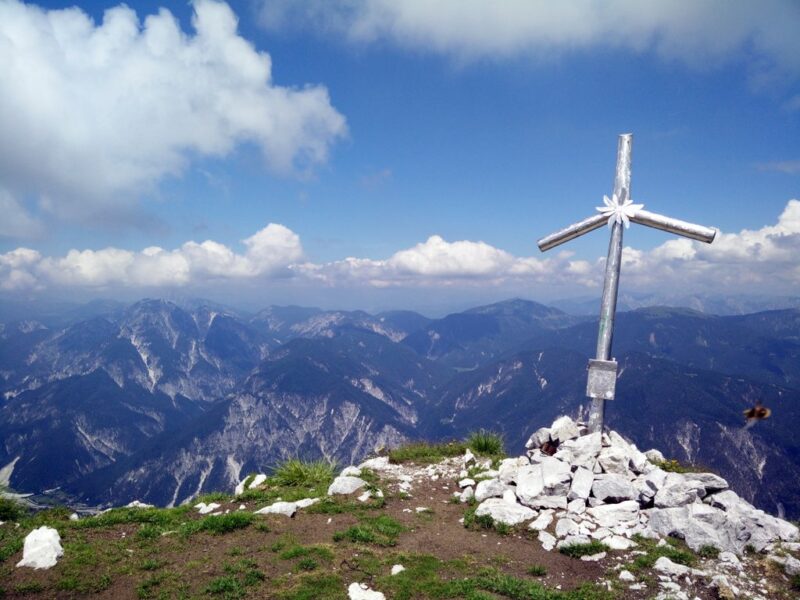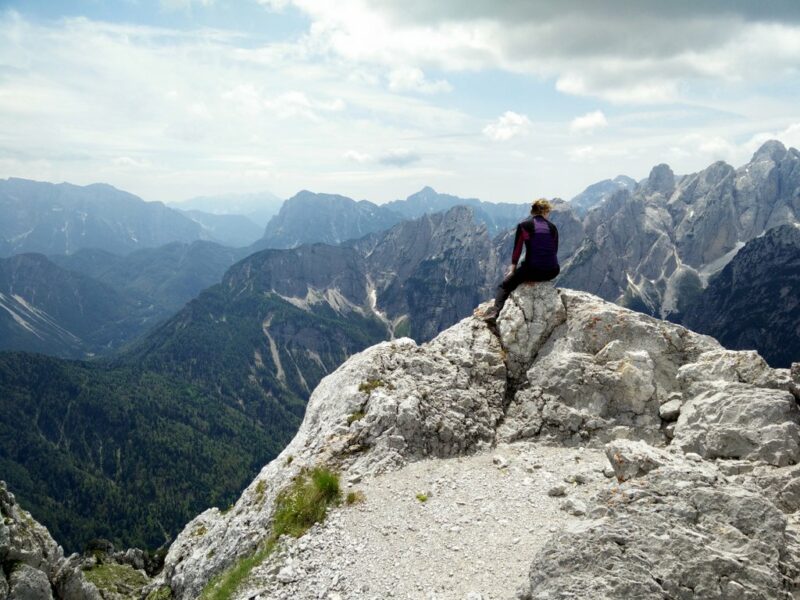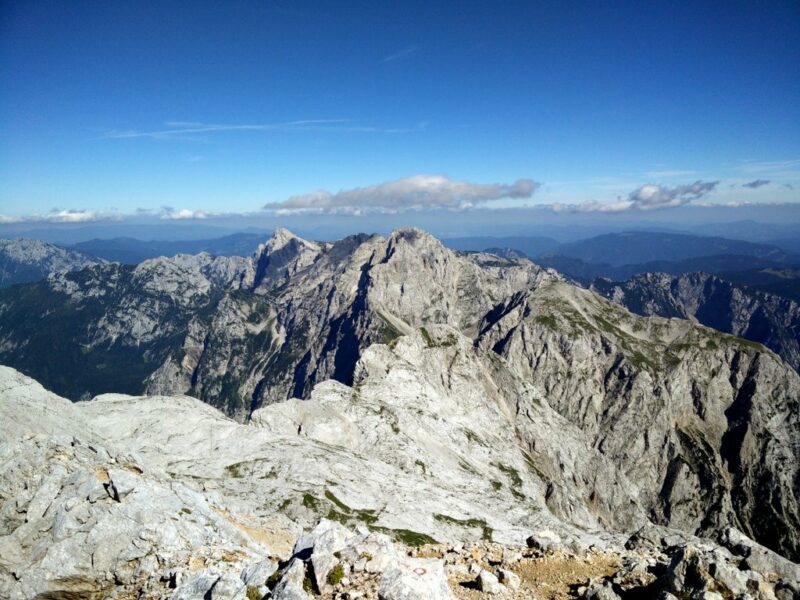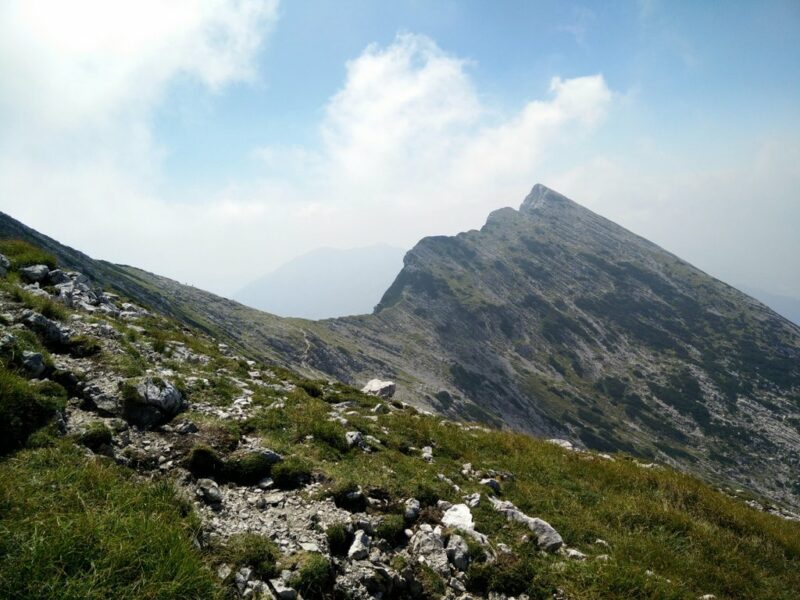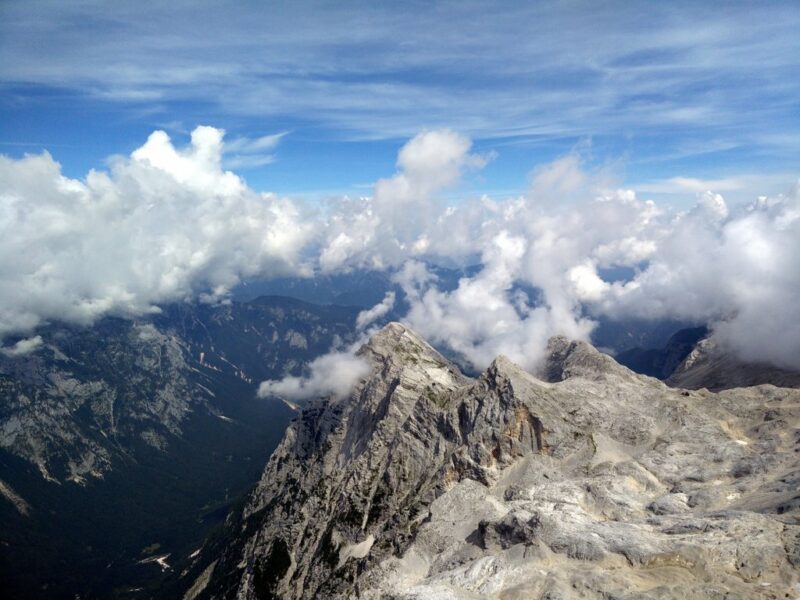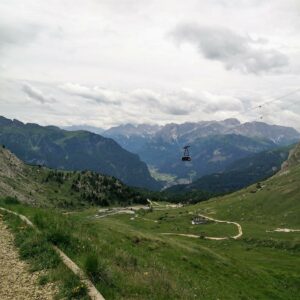In 2016 I conducted seven very different hiking trips in the eastern part of the Alps; two in Italy and five in neighboring Slovenia – a small Central European country with great possibilities for hiking and mountaineering. In the following I will describe some of the characteristics of alpine hiking as well as give you some tips to improve your hiking trips in the Alps. Although the Alps are an extensive mountain system that stretches over eight different countries the following tips are general enough to apply to most locations in this breath-taking mountain range.
Here are the 10 things you should know before going hiking in the Alps.
1. Weather
The weather in the Alps is really unpredictable – it is not impossible to encounter snow falls in summer (at high altitudes) as well as completely sunny and still weather in winter. However, summer days are usually relatively warm and the temperatures can easily exceed 30⁰C at low altitudes. Keep in mind that the temperatures decrease with an increase in altitude by approximately 1⁰C for every 100 meters. Sometimes it’s hard to get information about temperatures for certain locations (mountain huts, peaks etc.) and in such cases your best bet is to find the temperature for a town nearby and then estimate the temperature at a certain altitude by deducting 1⁰C for every 100 meters of altitude difference. While valleys are usually sheltered against strong winds, it’s a completely different story above the tree line – which in the Alps is at approximately 1600 meters above sea level. There it’s very likely that you will encounter strong winds eventually as the slopes and peaks are often very exposed. In summer thunderstorm are very common in the Alps and therefore there is a great danger of being hit by lightning. The only way to avoid this danger is to thoroughly check the weather forecast before going and to postpone the trip if thunderstorms are forecasted.
In winter the temperatures can drop down to -20⁰C in daytime and thus I highly recommend that you only go hiking if you have appropriate clothing that will keep you warm. Another thing to take into consideration is the day length. While summer days are quite long (up to 16 hours in June), winter days can be as short as eight hours (December). Therefore, hiking trips in winter should be carefully planned so that you don’t end up wandering around in the night – keep in mind that it’s easy to overestimate physical preparedness (and required time to execute a hike) in the Alps as distances are usually short but ascent/descent is much higher than anywhere else. It might be wise to bring a headlamp in any case.
2. Trails
The trails in the Alps are in general very well-marked with painted signs on rocks and trees as well as constructed direction signs and thus you shouldn’t have a lot of problems with navigation. However, in winter (and depending on the altitude, also in other seasons) the trails will be covered with deep snow and signs might be hard to see. Therefore, a navigation device might come in handy in snowy conditions while there is little need for it in summer days. Above the tree line (approximately 1600 meters above sea level) trails become very rocky and thus require appropriate footwear that offers good ankle support.
The snow line in the Alps (even during the warmest summers) is at approximately 2500 to 2800 meters above the sea level for northern slopes and 2700 to 2800 meters above the sea level for southern slopes. Reaching some peaks (such as Marmolada in Italy) might require crossing a glacier. If you expect snow or ice on the trail don’t forget to bring crampons and an ice axe as it is otherwise very likely that you will have to turn around before reaching the peak. In winter the snowline drops significantly and thus winter equipment (crampons, ice axe) is also required to reach even the lower peaks. It’s vital that you check snow conditions on the trail before going (no matter the season) so that you know what to expect and what gear to bring. Another thing to take into consideration is the technical complexity of the trail. The trails in the Alps greatly differ by technical complexity – some trails are very easy and suitable for everybody while others require quite some scrambling or via ferrata skills.
3. Via ferrata
In the Alps you will find numerous via ferrata trails. Via ferratas are steep and exposed trails running up and along abrupt hills and mountain sides, where the risk of a fatal fall is minimized by having a steel cable run along the trail. You can then attach yourself to the steel cable with a via ferrata set. In addition to a steel cable, via ferrata trails are usually also equipped with man-made footsteps, holds and even ladders. This allows hikers and mountaineers to reach relatively difficult summits without having extensive climbing skills. However, via ferratas are not for those who are uncomfortable with heights or completely new to hiking/mountaineering. Via ferratas can be found basically anywhere in the Alps but the particularly popular ones are mainly located in the Italian part of the Alps. Read more about how to use a via ferrata set here.
4. Altitudes
An increase in altitude entails not only a decrease in temperature, but also in the percentage of oxygen in the air. During my “Hiking the Alps” tour I’ve been regularly climbing peaks higher than 2000 meters and at this altitude I normally start to feel the effects of the decreased oxygen in the air – my performance is slightly diminished, the heart-rate increased and I literally feel that the air is thinner. How much the symptoms of increased altitude are felt, greatly depends on the individual. If you don’t have experience with hiking at high altitudes I recommend that you carefully monitor yourself as well as others in your group for symptoms of mountain sickness (shortness of breath, fatigue, insomnia etc.). In case that the symptoms become serious you should turn around and start descending for your own safety.
Another thing to keep in mind when planning hiking trips in the Alps is the total ascent/descent. Even though alpine hiking trips are usually relatively short by distance, they take plenty of time as the total ascent/descent is significant. For example when I was doing the Krn trail I only covered the distance of 12 kilometers, but as the total ascent/descent was 1706 meters I needed more than nine hours to execute this hike. In comparison I normally finish a 12 kilometers run in less than an hour on flat terrain.
5. Crowds
If you are planning to hike in very popular areas, prepare for the crowds – when I was doing the highly popular Triglav trail we were basically climbing the peak in a queue. As the trail was very narrow and exposed (as many trails in the Alps are) I had no chance to scramble my way past other hikers and therefore the hike took much longer than I anticipated. However, it is easy to avoid the crowds by climbing less popular peaks which are not necessarily less gorgeous. A good example of a hike like this is the Skuta trail where I met only a handful of people between the mountain hut and the summit.
6. Gear required
Hiking in the Alps is physically demanding as it involves a lot of ascending and descending and thus it is recommended to use lightweight equipment and to only bring the gear that you will actually need. The clothing and gear should be selected according to the weather forecast, conditions on the trail and trail’s technical complexity. However, do not go hiking in the Alps without a windproof/waterproof outer layer (due to unpredictable weather) and high-cut hiking boots that offer good ankle stability (for the rocky terrain). On technically challenging trails it is also highly recommended to use a via ferrata set, climbing harness and a helmet. While we could debate how necessary a via ferrata set is for some routes, I indeed recommend using a helmet most places as there is a great danger of falling stones. In any other season than summer it’s also very likely that you will need crampons and an ice axe to climb any mountain higher than 2500 meters (in winter 2000 meters).
7. Cable cars/Aerial Tramways
If you want to enjoy the beautiful peaks of the Alps, it is not always necessary that you are in a superb shape to reach them – instead you can use an aerial tramway to decrease the hiking trip’s ascent and duration. There are many aerial tramways in the Alps which make ascending high peaks much easier. In June I used an aerial tramway to reach Monte Lussari from where I climbed the 2074 meters high Cima del Cacciatore. On that hike I only made an ascent of 461 meters while a day before when I climbed Jof di Miezegnot (similar height but no cable car) the total ascent was nothing less than 1456 meters. All in all I think cable cars are terrific as they give an opportunity to less physically prepared hikers to climb fairly high peaks which would otherwise be inaccessible to them.
8. Reaching the trails
The trails in the Alps usually start at remote locations far away from bigger towns and thus reaching them can be a hassle if you don’t have a car. However, some trails can be reached by public transport (usually bus) but as public transport system is different in every country (or even municipality) quite some research is required to plan the journey. For day hikes I recommend renting a car as with a car you will reach the trail faster and easier than with the bus. Furthermore, you will also be more flexible – it’s no fun to run down the mountain to catch the last bus. For longer hikes it might be worth doing some research and taking a bus as it makes no sense to pay for a car that will be parked while you are hiking. For Slovenia, check out the national railways and the website for the bus station of the capital Ljubljana where you can find all regional bus routes. For Italy, it is quite easy to check out train schedules at Tren Italia while you should be able to find bus schedules (‘orari’) if you search for “bus + name” of a bigger town in vicinity of the trail you want to do – for example “bus Livogno”. Be prepared to use Google Translate and some patience.
9. Supplies and accommodation
Most trails in the Alps have mountain huts along the way which usually do not only provide accommodation but also drinks and cooked meals. Thus, you don’t have to carry larger food supplies if you are anyway passing by a mountain hut on your way.
However, I recommend bringing some food and a good amount of water with you as mountain huts are relatively pricey – a bottle of water can cost as much as 5 € ($ 5.4). At some mountain huts, especially at lower altitudes, the tapped water is drinkable and thus you can refill your water bottles for free. Sleeping in a mountain hut is actually relatively inexpensive; in the Slovenian Alps it will cost you from 21 € ($ 22.9) to 27 € ($ 29.4) depending on the room type and mountain hut type. Those who prefer camping should first check the national camping rules as it is not allowed to pitch the tent everywhere. In Slovenia it is generally forbidden to camp anywhere except in campsites. As the mountain huts are relatively inexpensive I indeed recommend sleeping there.
10. Alert
By the end of August 2016 while I was hiking in the Alps, there had already been 10 casualties during the hiking season in the Slovenian Alps alone due to various reasons. The most common hazards in the Alps include avalanches, lightning strikes and slips. While the first two hazards can be predicted somewhat by checking the weather forecast and conditions on the trail ahead of a hike, you need good hiking/mountaineering skills to avoid slips – which can prove fatal. I recommend that you do not take on technically challenging trails unless you have the appropriate skills and experience. If you should ever wander off the trail, it is important that you use the same way back to the trail as soon as you figure out that you missed the direction, since continuing off trail will most likely lead you to unsecured and technically challenging terrain. Additionally, I recommend that you always let somebody know where and for how long you are planning to hike so that they know where look for you if you don’t return in time.
Photo Gallery
Here are some photos which I took on my seven hiking trips. For more photos please check the hiking the Alps section.
I’d love to hear your thoughts on hiking in the Alps. Write them in the comments section below.


